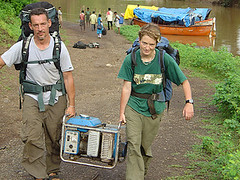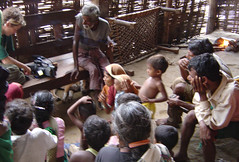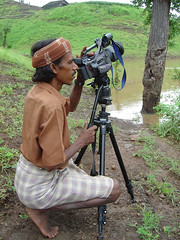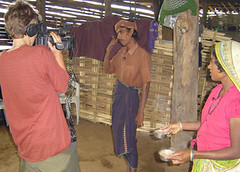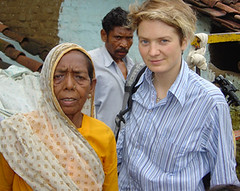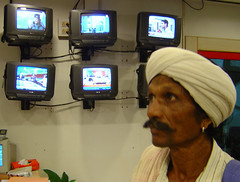Cinema Jalsindhi
August 2003: A year after completing Drowned Out, the Spanner Films crew set off on an epic journey towards Jalsindhi village in Madhya Pradesh to screen the film for the stars of the documentary, for whom it will be the first time they've ever seen a moving image.
The short film (below) and loads of other extras (four hours in total), including a commentary track with the tribal star of the film, Luharia Sonkaria, are all contained on the Drowned Out DVD, very reasonably priced (look at what we had to go through!) at 12 English pounds.
|
Two hundred people from the surrounding villages turned out.
|
Two weeks of manic preparation did little to ready us for our madcap India mission. In the midst of packing for a shoot in a remote tribal village we were desperately trying to finish a Hindi version of the film (made possible by a grant from The Funding Network) to screen while we are here. The final sound mix fell off the bottom of our 'to do' list, but Neil Hipkiss at Master Tracks kindly saved the day after we'd left the country and posted the screenings tapes on to us.
Getting anything done here is a real achievement. The glass half full part of me would describe it as 'an exercise in problem solving', but the half empty part would have to call it intensely frustrating. The technological equipment we have burned through in two weeks reads like a trailer for an admin horror movie: three mobile phones, six sim cards, two computers, two TVs, two video players and three internet accounts.
We blame 5 overnight trains in 7 days for the inappropriate levels of intimacy we have sunk to - Franny having to wear my stinky wet socks to ward off her blister agony as we trudged through rivers - and the fact we only speak to each other in pigeon English. Yesterday Raymond straightfacedly asked me 'you go train now?'.
First stop: the slums
There were some emotional reactions to the film, understandably enough, as they were watching their old way of life and a depiction of how this had changed after the submergence of their villages. Bugiabhai, the grandmother, had to leave half way through as she found it so upsetting. Hopefully the screening was a positive experience for them and we felt privileged to be share the viewing the film with them. (Was probably a mistake to pass sweets round half way through as such a scrum ensued that the film had to be stopped until the kids calmed down.)
**The DVD contains a short update from the Jabuplur people and even a happy ending from some other Bargi-dam displacees **
The big one - Jalsindhi itself
Lugging our generator, cameras, projector, petrol, biscuits, cigarettes and balloons (to placate village children), we set off from our flat. First disaster: the 4 wheel drive jeep that we'd arranged to meet didn't turn up. So after spending the night in our bug infested 2-wheel drive jeep - and the first of many biscuits with biscuits meals - we finally risked driving the treacherous dirt track cum river valley ourselves - and managed to get safely to the makeshift boat jetty. Our boat, predictably, was nowhere to be seen. However Jayesh 'no problem' Kothi (our handy Indian fixer) bribed some passing boatmen, siphoned petrol from our generator for their boat and we were off.
Seeing Franny reunited with Luhariya and the rest of the villagers - she'd spent about 8 weeks with them on and off during the 3 year process of making the film - was deeply touching. For myself, meeting Luhariya and Bulgi felt like mixing with movie stars. I constantly got the feeling we had stepped into a shot from Drowned Out and were about to be edited away from. The Adivasi tribal villagers, many who had never seen a film before, were intrigued by the process of setting up our mobile cinema. Every move we made was scrutinised by eager, curious faces.
Our previous two screenings had trained us well and the small matter of the missing lead to connect the projector to the generator was solved by Raymond making a converter plug from some twigs (honest!). The two double bed sheets we had sewn together were hung on the side of the school, the speakers were fixed up with string and the whole village, led by the most enthusiastic, wide-eyed kids I've ever seen, gathered to watch.
It was incredibly rewarding to watch the watchers. The children were completely captivated and in fits of hysterics whenever someone they knew came on screen. Although we didn't understand a word of what the kids were saying (the villagers speak their own tribal dialect - Bhilali) we got the distinct impression that Luhariya's kids will never live down those naked swimming shots! Everyone we asked loved seeing the film and thought it told their story well. Luhariya said that it had all the elements of the Adivasi way of life and that seeing so much of himself on screen made him feel 'nice, but heavy'. ***Watch this space for news on our DVD [available now from our online shop] which will include a commentary by Luhariya about what he made of the whole process of being in the film-including whether he thought Franny was completely mad with her strange requests such as getting him to wear the same thing on different days (continuity) and getting him to repeat specific movements (close ups and wides). We don't know the answers yet as we have still to get it translated!***
In terms of what is happening in Jalsindhi, the situation is severe and has worsened considerably since completion of the film. Luhariya's house was submerged during last year's monsoon and he now lives in a new one further up the hill. However this new one, which looks to be about 20 metres higher, will also be submerged even at the current height of the dam, depending on the strength of the monsoon. He has lost all of his land and crops and so most of his family's food is donated by other villagers. He has not been offered land, only cash now, and is adamant he will not leave Jalsindhi. There are also serious health problems increasing in the valley. The NBA reported recently that many people do not have proper drinking water, shelter or food. Meanwhile the government is pushing ahead with the newest dam, Indira Sargar, which will affect 129,000 people.
And if we thought our trip in was hard going, our two day journey back had all the elements needed for a great drama (maybe even a western) including; By Lizzie Gillett |

